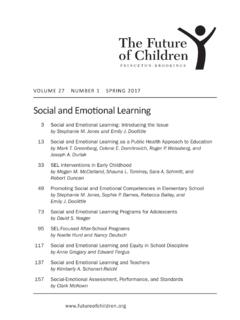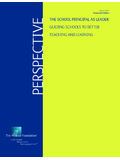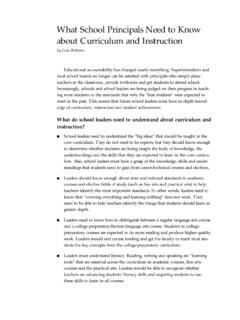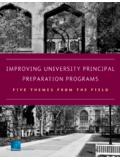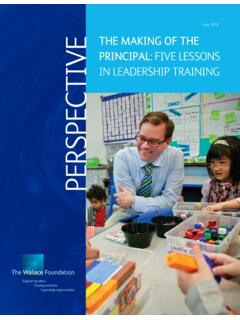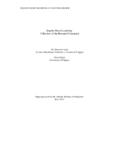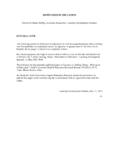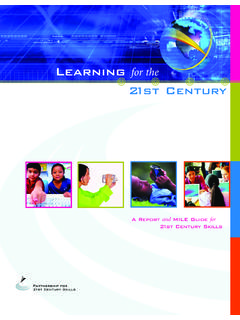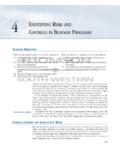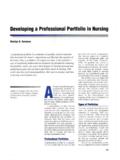Transcription of THE EFFECTIVE PRINCIPAL By Pamela Mendels W
1 JSD | February 2012 | Vol. 33 No. 1545 PIVOTAL PRACTICES THAT SHAPE INSTRUCTIONAL LEADERSHIPBy Pamela MendelsW hen most people hear the word PRINCIPAL , they think of the noun meaning the chief, the top executive, the head of all others, the person who controls the levers. Not so Dewey Hensley, himself a former PRINCIPAL and today an assistant commissioner in Kentucky s Department of Education. Hensley likes to re-mind people that when it was first used in connection with school leadership in the 1800s, the word PRINCIPAL was an adjective in front of another word, teacher (Pierce, 1935, p. 11). The PRINCIPAL teacher, he says, was a kind of first among equals, an instructor who assumed some adminis-trative tasks as schools began to grow beyond the one-room buildings of yore. The original PRINCIPAL , Hensley stresses, was, like the other teachers in the school, concerned with instruction above all.
2 Principals in the 21st century, he says, could do worse than keep this 19th-century definition in mind as they face the challenges of turning around failing schools and work to live up to the ideals embodied in a more contemporary term, instructional leader. Today s best principals, Hens-ley says, know what good and EFFECTIVE instruction looks like so they can provide feedback to guide teachers. This view of the principalship that it should cen-ter on instruction, not building management or other ad-ministrative matters is one that has gained currency in recent years. So has the idea that if instruction is the heart of their job, principals have a vital role to play in school improvement. Consider a 2010 survey of school and district administrators, policy advisers, and others in the education world. They named PRINCIPAL leadership as second only to teacher quality when they were asked to rank in importance 21 education issues, ranging from special education and English language learning to school violence and reducing the dropout rate (Simkin, Charner, & Suss, 2010, pp.)
3 9-10).A major reason for the attention being paid to prin-cipals is the emergence of research that has found an empirical link between school leadership and student achievement. A seminal 2004 study, How Leadership In-feature LEADERSHIP THE EFFECTIVE PRINCIPALF ebruary 2012 | Vol. 33 No. 1 | JSD55fluences Student learning , asserted that leadership was the second most important school-based factor in children s academic achievement and noted that there were few, if any, cases of troubled schools turning around without EFFECTIVE leaders (Leithwood, Louis, Anderson, & Wahl-strom, 2004). In 2010, the authors of that study, a team of researchers from the University of Minnesota and the University of Toronto, published a detailed sequel to probe school leadership in depth. They reaffirmed their earlier conclusion, declaring that: In developing a starting point for this six-year study, we claimed, based on a preliminary review of research, that leadership is second only to class-room instruction as an influence on student learning .
4 After six additional years of research, we are even more confident about this claim (Louis, Leithwood, Wahlstrom, & An-derson, 2010, p. 9). And they found, further, that although school leadership does not make its impact directly, its indirect workings have a statistically significant effect on student achievement (Louis et al., 2010, p. 37). What exactly is it that EFFECTIVE principals do that ripples through classrooms and boosts learning , especially in failing schools? Since 2000, The Wallace Foundation, which has supported projects to promote education leader-ship in 24 states and published 70 reports on the subject (including the Minnesota/Toronto research), has been try-ing to answer that question. A recently published Wallace Perspective report that takes a look back at the founda-tion s research and field experiences finds that five prac-tices in particular seem central to EFFECTIVE school leadership (The Wallace Foundation, 2012): 1.
5 Shaping a vision of academic success for all students, one based on high standards;2. Creating a climate hospitable to education in order that safety, a cooperative spirit, and other foundations of fruitful interaction prevail;3. Cultivating leadership in others so that teachers and other adults assume their part in realizing the school vision;4. Improving instruction to enable teachers to teach at their best and students to learn at their utmost; and5. Managing people, data and processes to foster school principals put each of these elements in place and in harmony principals stand a fighting chance of making a real difference for students. SHAPING A VISIONE ffective leadership begins with the develop-ment of a schoolwide vision of commitment to high standards and the success of all students. The PRINCIPAL helps to spell out that vision and get all others on board with it. The research literature over the last quarter-century has consistently supported the notion that having high expectations for all, including clear and public standards, is one key to closing the achievement gap between advantaged and less advantaged students and for raising the overall achievement of all students, write education leadership researchers at Vanderbilt University (Porter et al.)
6 , 2008, p. 13).The Minnesota/Toronto team found that principals rated highly by teachers for having created a good in-structional climate or taken sound instructional actions had been able to nurture a strong vision that all students can learn. Clearly, what gets the highly rated principals out of bed each morning is what keeps them awake at night: They have a vision and believe that all students can achieve at high levels, the researchers say.. They emphasize the value of research-based strategies. They speak about the amount of time that is invested in developing the school s vision, gathering research infor-mation, and then applying it to the local set-ting. In one passage, the researchers quote a teacher and the PRINCIPAL at a school where the vision has been securely planted: My PRINCIPAL is very firm in what she believes, the teacher tells the researchers. For her part, the PRINCIPAL makes clear that the vision is nonnegotiable, as the re-searchers put it, commenting that her expectations are high and the teachers know that.
7 I simply put it out there: We ve got to kick it up a notch, the PRINCIPAL says (Louis et al., 2010, p. 84).CREATING A CLIMATE HOSPITABLE TO EDUCATION To be sure, EFFECTIVE principals shape schools buildings characterized by the basics safety and orderliness but they also see to it that schools create an atmosphere in which students feel supported and responded to. For teachers, too, prin-cipals set a tone. The feel is nonbureaucratic, and teach-ers form part of a professional community that is deeply rooted in the academic and social learning goals of the schools (Goldring, Porter, Murphy, Elliott, & Cravens, 2007, pp. 7-8). Principals ensure that teachers do not work in isolation from one another, but work collaboratively, giving each other help and guidance to improve instruc-tional practices (Louis et al., 2010, p. 50). EFFECTIVE principals work hard at building such school communities, found University of Washington researchers in an examination of leadership in urban schools.
8 Along-side their efforts to prioritize collaboration and address trust in the building, the principals, aided by other admin-feature LEADERSHIP12 This article is sponsored by The Wallace | February 2012 | Vol. 33 No. 156istrative staff, made improvement of the work culture a central target of their efforts to lead a learning improvement agenda, the researchers found. Some had arrived at their job feeling that they needed to change a toxic culture at the school to do what they needed to do. Other spoke of building a culture, moving toward a culture, or leading a culture of change. The University of Washington researchers went on to list the key elements of a climate hospitable to learning : a sense of student and staff safety; respect for all members of the school community, without regard to the professional status or po-sition; an upbeat, welcoming, solution-oriented, no-blame, professional environment; an effort to invite and involve staff in various schoolwide functions; and a parallel outreach to stu-dents that engaged and involved them in a variety of activities (Portin et al.)
9 , 2009, p. 59).CULTIVATING LEADERSHIP IN OTHERSE ffective principals know they cannot go it alone. They are not the lonely-at-the-top, hero- PRINCIPAL who has become a fixture of popular culture. Instead, they make good use of all the skills and knowledge on the faculty and among others, encouraging the many capable adults who make up a school community to step into leadership roles and responsibilities. The more open a PRINCIPAL is to spreading leadership around, the better it is for student learning , the Minnesota/Toronto researchers found. Indeed, a particularly notable find-ing of their study is that EFFECTIVE leadership from a variety of sources principals, teachers, staff teams and others is as-sociated with better student performance on math and reading tests. Compared with lower-achieving schools, higher-achiev-ing schools provided all stakeholders with greater influence on decisions, the report says.
10 It then goes on to explore why, sug-gesting that when it comes to leadership, the adage about two (or more) heads being better than one applies. The higher per-formance of these schools might be explained as a consequence of the greater access they have to collective knowledge and wis-dom embedded within their communities, the researchers say (Louis et al., 2010, p. 35). What s more, leadership appears not to be a zero sum game. The researchers found that principals do not lose influence as others gain influence (Louis et al., 2010, p. 19).IMPROVING INSTRUCTIONE ffective leaders focus laser-like on the quality of instruction in their schools. As the Wallace Per-spective notes, They emphasize research-based strat-egies to improve teaching and learning and initiate discussions about instructional approaches, both in teams and with individual teachers. They pursue these strategies despite the preference of many teachers to be left alone (The Wallace Foundation, 2012).
